Financial Management Report: Task 4 - Finance Role and Sources
VerifiedAdded on 2023/06/08
|6
|1294
|295
Report
AI Summary
This report provides an overview of financial management, defining it as the strategic handling of monetary resources to achieve organizational goals. It emphasizes the importance of finance functions, such as economic planning, financial acquisition, and fund utilization. The report also details the role of a finance manager, including capital computation, investment, profit allocation, and fund management. Furthermore, it analyzes various sources of finance, categorizing them into long-term (equity shares, term loans, retained earnings) and short-term (bank overdraft, bank loan, trade credit) options, providing insights into how businesses can secure funds for their operations. The report includes a comprehensive list of references to support its findings.
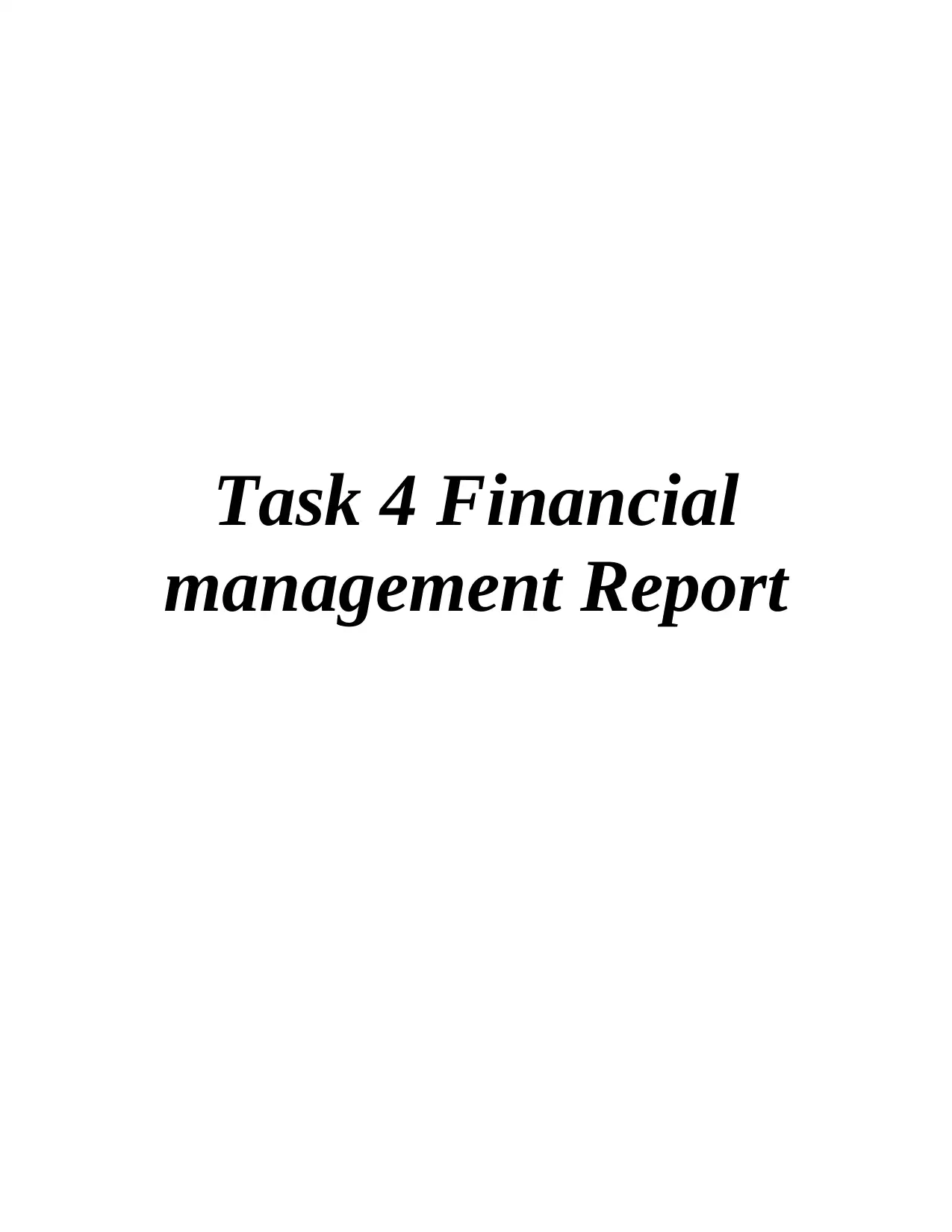
Task 4 Financial
management Report
management Report
Paraphrase This Document
Need a fresh take? Get an instant paraphrase of this document with our AI Paraphraser
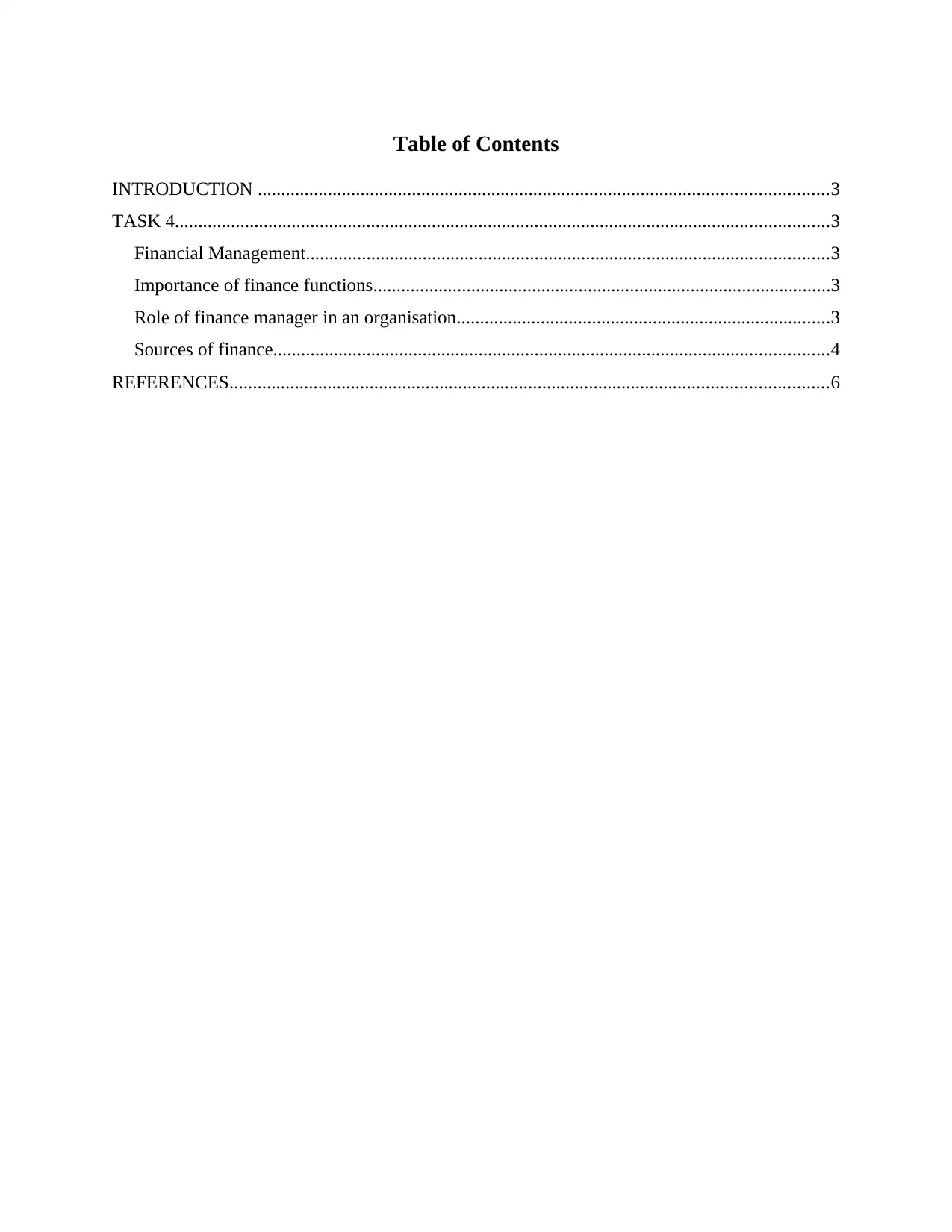
Table of Contents
INTRODUCTION ..........................................................................................................................3
TASK 4............................................................................................................................................3
Financial Management................................................................................................................3
Importance of finance functions..................................................................................................3
Role of finance manager in an organisation................................................................................3
Sources of finance.......................................................................................................................4
REFERENCES................................................................................................................................6
INTRODUCTION ..........................................................................................................................3
TASK 4............................................................................................................................................3
Financial Management................................................................................................................3
Importance of finance functions..................................................................................................3
Role of finance manager in an organisation................................................................................3
Sources of finance.......................................................................................................................4
REFERENCES................................................................................................................................6

INTRODUCTION
Financial management define as a procedure of handling and controlling monetry
resources to meet organisational goal and objectives (Bara and Pradesyah., 2021). Financial
management is the control of financial actions, strategic design, administration and direction in a
firm / institution. It also includes the application of management principles to firm's financial
resource, at the time also performing an crucial role in fiscal management. This report include
benefits of financial management within the organisation. Further it explain the role of financial
manager in a company. There are various sources of finance is analysed which help firm to raise
funds.
TASK 4
Financial Management
Financial management is considered as an application of basic managerial principles to the p[art
of financial decision making. Financial management control of procurement methods and robust
acquisition and deployment of all procedures related to each short term and long term monetary
asset as they relate to the acquisition of products and services (Brigham and Houston., 2021). It
is an essential process which reduce the wastage of financial resources and helpful in best
utilisation of the financial resources.
Importance of finance functions
Helping businesses formulate economic plans
Help the firm in planning and acquisition of finance.
To help businesses effectively utilize and distribute funds obtained or acquired
Help the company in making important financial decisions
Assist to enhance the profitability of the business
Enhance the overall value of the company
provide financial balance
Employees are encouraged to save money, that assist them in private monetry plans.
Role of finance manager in an organisation
Computing the capital required: Financial manager must compute the amount of
capital required by the business. It depends on organizational rules close to expected costs and
Financial management define as a procedure of handling and controlling monetry
resources to meet organisational goal and objectives (Bara and Pradesyah., 2021). Financial
management is the control of financial actions, strategic design, administration and direction in a
firm / institution. It also includes the application of management principles to firm's financial
resource, at the time also performing an crucial role in fiscal management. This report include
benefits of financial management within the organisation. Further it explain the role of financial
manager in a company. There are various sources of finance is analysed which help firm to raise
funds.
TASK 4
Financial Management
Financial management is considered as an application of basic managerial principles to the p[art
of financial decision making. Financial management control of procurement methods and robust
acquisition and deployment of all procedures related to each short term and long term monetary
asset as they relate to the acquisition of products and services (Brigham and Houston., 2021). It
is an essential process which reduce the wastage of financial resources and helpful in best
utilisation of the financial resources.
Importance of finance functions
Helping businesses formulate economic plans
Help the firm in planning and acquisition of finance.
To help businesses effectively utilize and distribute funds obtained or acquired
Help the company in making important financial decisions
Assist to enhance the profitability of the business
Enhance the overall value of the company
provide financial balance
Employees are encouraged to save money, that assist them in private monetry plans.
Role of finance manager in an organisation
Computing the capital required: Financial manager must compute the amount of
capital required by the business. It depends on organizational rules close to expected costs and
⊘ This is a preview!⊘
Do you want full access?
Subscribe today to unlock all pages.

Trusted by 1+ million students worldwide
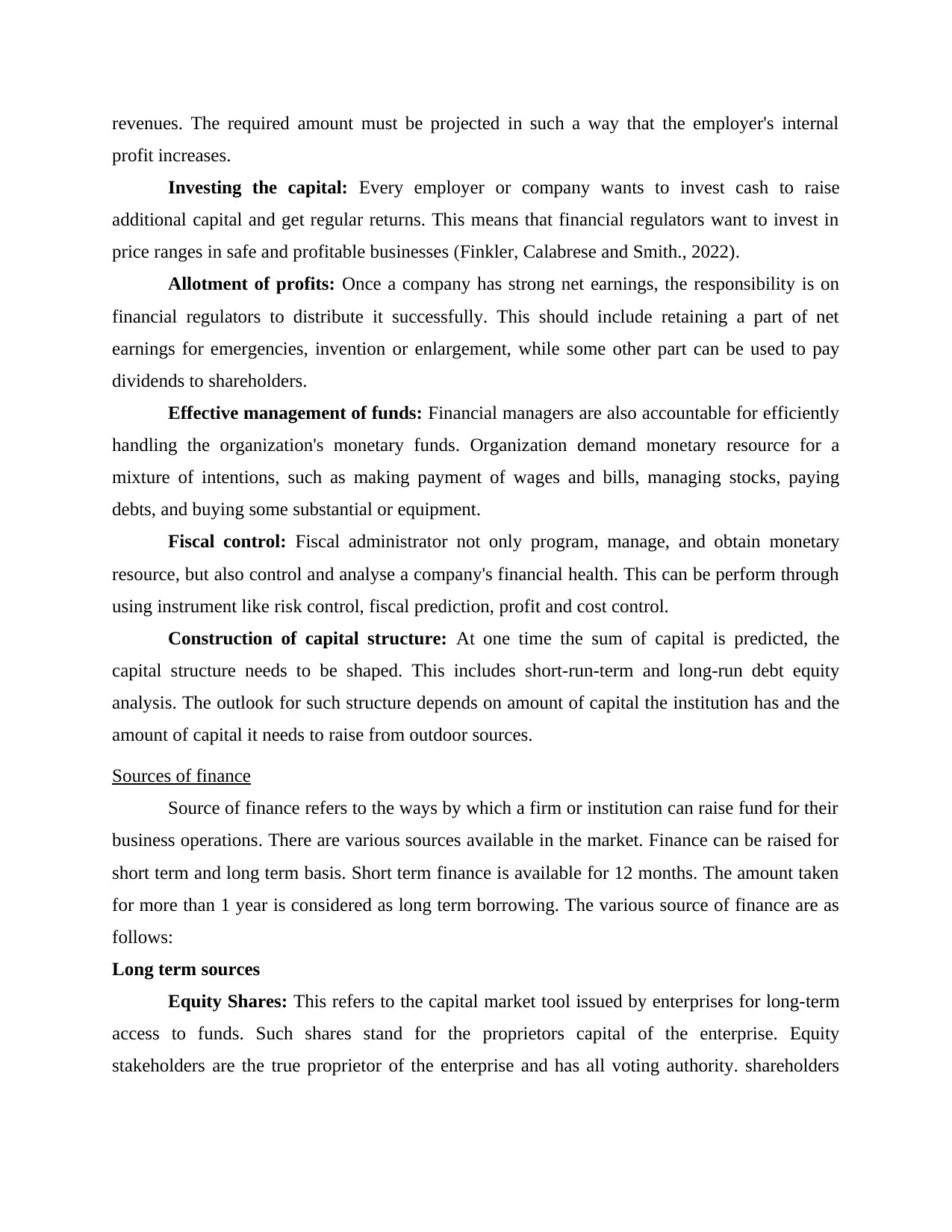
revenues. The required amount must be projected in such a way that the employer's internal
profit increases.
Investing the capital: Every employer or company wants to invest cash to raise
additional capital and get regular returns. This means that financial regulators want to invest in
price ranges in safe and profitable businesses (Finkler, Calabrese and Smith., 2022).
Allotment of profits: Once a company has strong net earnings, the responsibility is on
financial regulators to distribute it successfully. This should include retaining a part of net
earnings for emergencies, invention or enlargement, while some other part can be used to pay
dividends to shareholders.
Effective management of funds: Financial managers are also accountable for efficiently
handling the organization's monetary funds. Organization demand monetary resource for a
mixture of intentions, such as making payment of wages and bills, managing stocks, paying
debts, and buying some substantial or equipment.
Fiscal control: Fiscal administrator not only program, manage, and obtain monetary
resource, but also control and analyse a company's financial health. This can be perform through
using instrument like risk control, fiscal prediction, profit and cost control.
Construction of capital structure: At one time the sum of capital is predicted, the
capital structure needs to be shaped. This includes short-run-term and long-run debt equity
analysis. The outlook for such structure depends on amount of capital the institution has and the
amount of capital it needs to raise from outdoor sources.
Sources of finance
Source of finance refers to the ways by which a firm or institution can raise fund for their
business operations. There are various sources available in the market. Finance can be raised for
short term and long term basis. Short term finance is available for 12 months. The amount taken
for more than 1 year is considered as long term borrowing. The various source of finance are as
follows:
Long term sources
Equity Shares: This refers to the capital market tool issued by enterprises for long-term
access to funds. Such shares stand for the proprietors capital of the enterprise. Equity
stakeholders are the true proprietor of the enterprise and has all voting authority. shareholders
profit increases.
Investing the capital: Every employer or company wants to invest cash to raise
additional capital and get regular returns. This means that financial regulators want to invest in
price ranges in safe and profitable businesses (Finkler, Calabrese and Smith., 2022).
Allotment of profits: Once a company has strong net earnings, the responsibility is on
financial regulators to distribute it successfully. This should include retaining a part of net
earnings for emergencies, invention or enlargement, while some other part can be used to pay
dividends to shareholders.
Effective management of funds: Financial managers are also accountable for efficiently
handling the organization's monetary funds. Organization demand monetary resource for a
mixture of intentions, such as making payment of wages and bills, managing stocks, paying
debts, and buying some substantial or equipment.
Fiscal control: Fiscal administrator not only program, manage, and obtain monetary
resource, but also control and analyse a company's financial health. This can be perform through
using instrument like risk control, fiscal prediction, profit and cost control.
Construction of capital structure: At one time the sum of capital is predicted, the
capital structure needs to be shaped. This includes short-run-term and long-run debt equity
analysis. The outlook for such structure depends on amount of capital the institution has and the
amount of capital it needs to raise from outdoor sources.
Sources of finance
Source of finance refers to the ways by which a firm or institution can raise fund for their
business operations. There are various sources available in the market. Finance can be raised for
short term and long term basis. Short term finance is available for 12 months. The amount taken
for more than 1 year is considered as long term borrowing. The various source of finance are as
follows:
Long term sources
Equity Shares: This refers to the capital market tool issued by enterprises for long-term
access to funds. Such shares stand for the proprietors capital of the enterprise. Equity
stakeholders are the true proprietor of the enterprise and has all voting authority. shareholders
Paraphrase This Document
Need a fresh take? Get an instant paraphrase of this document with our AI Paraphraser
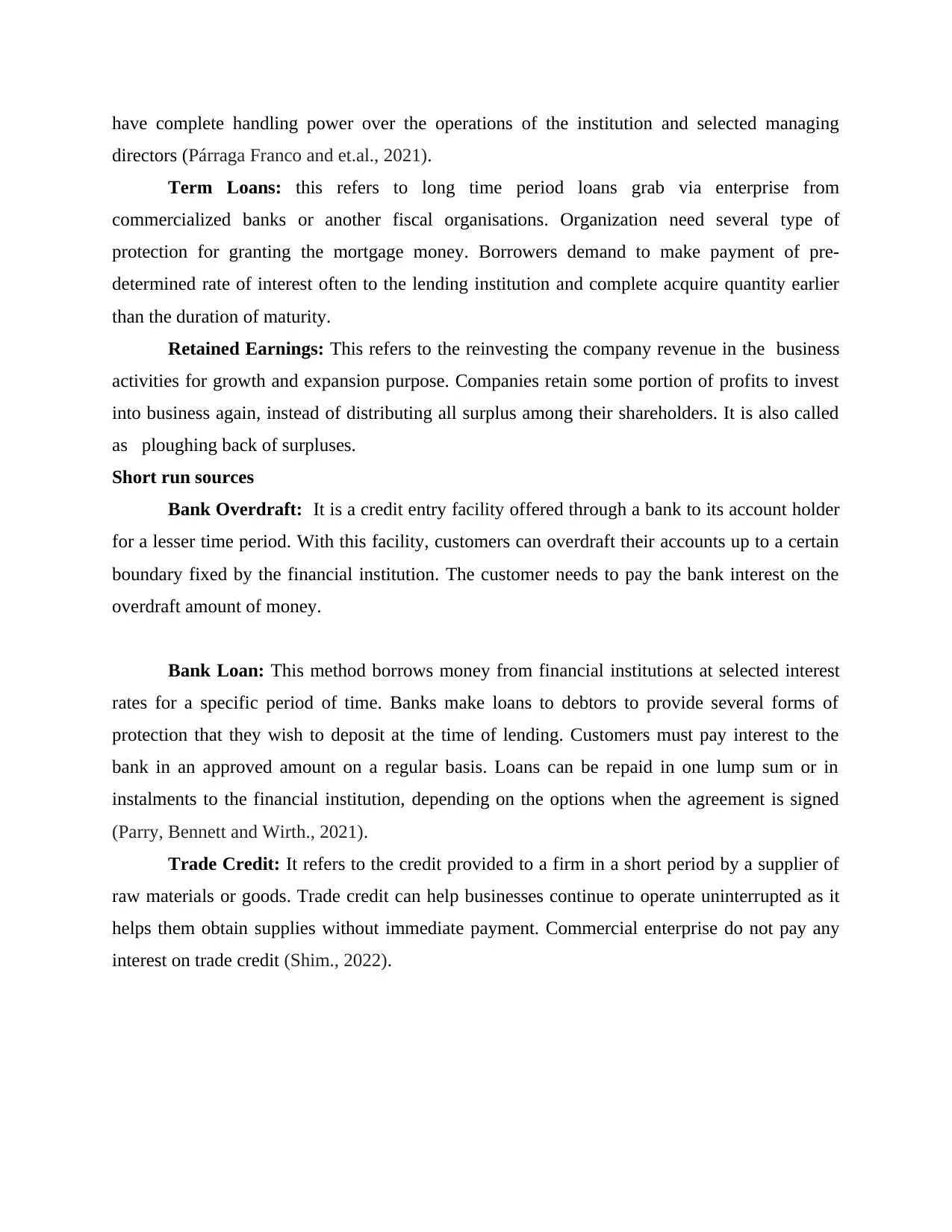
have complete handling power over the operations of the institution and selected managing
directors (Párraga Franco and et.al., 2021).
Term Loans: this refers to long time period loans grab via enterprise from
commercialized banks or another fiscal organisations. Organization need several type of
protection for granting the mortgage money. Borrowers demand to make payment of pre-
determined rate of interest often to the lending institution and complete acquire quantity earlier
than the duration of maturity.
Retained Earnings: This refers to the reinvesting the company revenue in the business
activities for growth and expansion purpose. Companies retain some portion of profits to invest
into business again, instead of distributing all surplus among their shareholders. It is also called
as ploughing back of surpluses.
Short run sources
Bank Overdraft: It is a credit entry facility offered through a bank to its account holder
for a lesser time period. With this facility, customers can overdraft their accounts up to a certain
boundary fixed by the financial institution. The customer needs to pay the bank interest on the
overdraft amount of money.
Bank Loan: This method borrows money from financial institutions at selected interest
rates for a specific period of time. Banks make loans to debtors to provide several forms of
protection that they wish to deposit at the time of lending. Customers must pay interest to the
bank in an approved amount on a regular basis. Loans can be repaid in one lump sum or in
instalments to the financial institution, depending on the options when the agreement is signed
(Parry, Bennett and Wirth., 2021).
Trade Credit: It refers to the credit provided to a firm in a short period by a supplier of
raw materials or goods. Trade credit can help businesses continue to operate uninterrupted as it
helps them obtain supplies without immediate payment. Commercial enterprise do not pay any
interest on trade credit (Shim., 2022).
directors (Párraga Franco and et.al., 2021).
Term Loans: this refers to long time period loans grab via enterprise from
commercialized banks or another fiscal organisations. Organization need several type of
protection for granting the mortgage money. Borrowers demand to make payment of pre-
determined rate of interest often to the lending institution and complete acquire quantity earlier
than the duration of maturity.
Retained Earnings: This refers to the reinvesting the company revenue in the business
activities for growth and expansion purpose. Companies retain some portion of profits to invest
into business again, instead of distributing all surplus among their shareholders. It is also called
as ploughing back of surpluses.
Short run sources
Bank Overdraft: It is a credit entry facility offered through a bank to its account holder
for a lesser time period. With this facility, customers can overdraft their accounts up to a certain
boundary fixed by the financial institution. The customer needs to pay the bank interest on the
overdraft amount of money.
Bank Loan: This method borrows money from financial institutions at selected interest
rates for a specific period of time. Banks make loans to debtors to provide several forms of
protection that they wish to deposit at the time of lending. Customers must pay interest to the
bank in an approved amount on a regular basis. Loans can be repaid in one lump sum or in
instalments to the financial institution, depending on the options when the agreement is signed
(Parry, Bennett and Wirth., 2021).
Trade Credit: It refers to the credit provided to a firm in a short period by a supplier of
raw materials or goods. Trade credit can help businesses continue to operate uninterrupted as it
helps them obtain supplies without immediate payment. Commercial enterprise do not pay any
interest on trade credit (Shim., 2022).
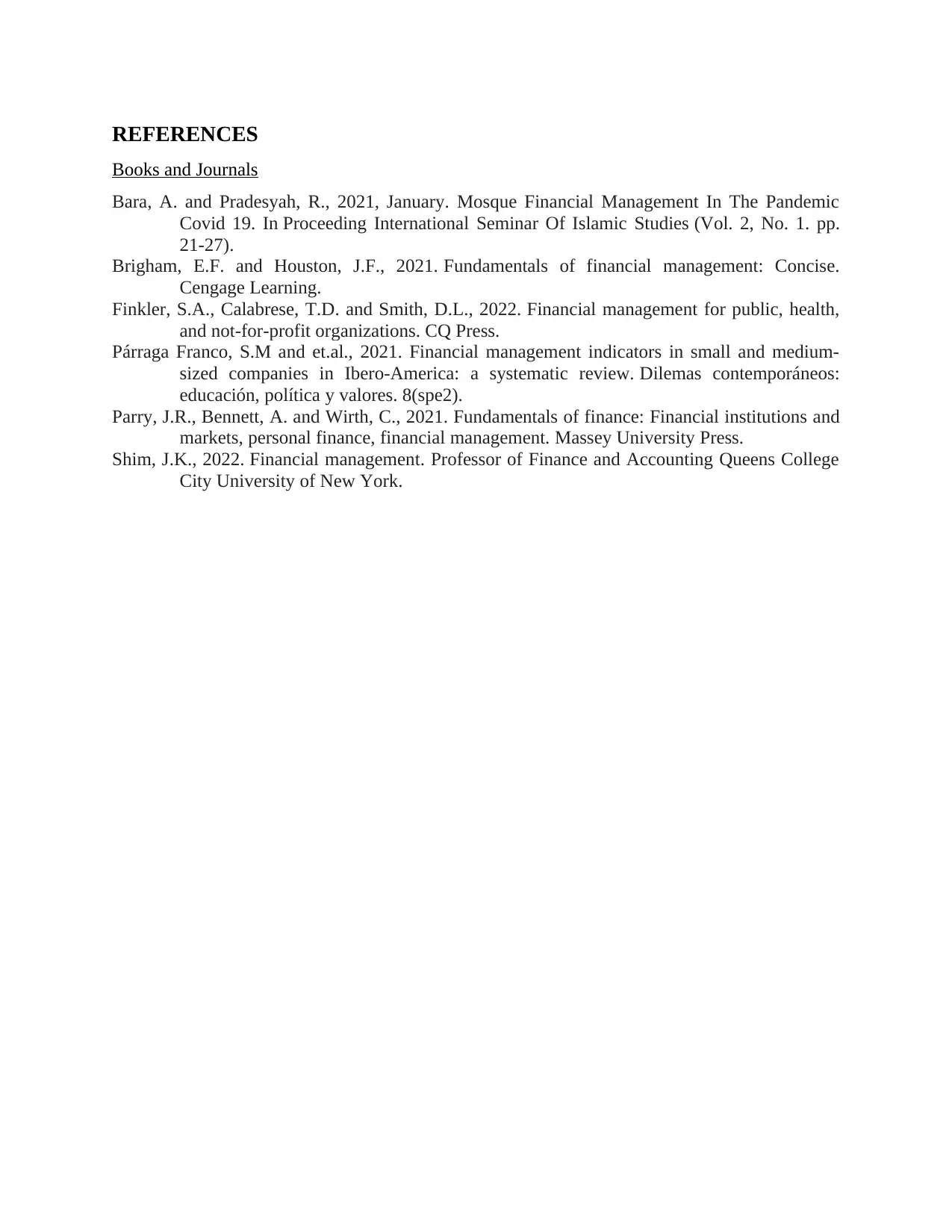
REFERENCES
Books and Journals
Bara, A. and Pradesyah, R., 2021, January. Mosque Financial Management In The Pandemic
Covid 19. In Proceeding International Seminar Of Islamic Studies (Vol. 2, No. 1. pp.
21-27).
Brigham, E.F. and Houston, J.F., 2021. Fundamentals of financial management: Concise.
Cengage Learning.
Finkler, S.A., Calabrese, T.D. and Smith, D.L., 2022. Financial management for public, health,
and not-for-profit organizations. CQ Press.
Párraga Franco, S.M and et.al., 2021. Financial management indicators in small and medium-
sized companies in Ibero-America: a systematic review. Dilemas contemporáneos:
educación, política y valores. 8(spe2).
Parry, J.R., Bennett, A. and Wirth, C., 2021. Fundamentals of finance: Financial institutions and
markets, personal finance, financial management. Massey University Press.
Shim, J.K., 2022. Financial management. Professor of Finance and Accounting Queens College
City University of New York.
Books and Journals
Bara, A. and Pradesyah, R., 2021, January. Mosque Financial Management In The Pandemic
Covid 19. In Proceeding International Seminar Of Islamic Studies (Vol. 2, No. 1. pp.
21-27).
Brigham, E.F. and Houston, J.F., 2021. Fundamentals of financial management: Concise.
Cengage Learning.
Finkler, S.A., Calabrese, T.D. and Smith, D.L., 2022. Financial management for public, health,
and not-for-profit organizations. CQ Press.
Párraga Franco, S.M and et.al., 2021. Financial management indicators in small and medium-
sized companies in Ibero-America: a systematic review. Dilemas contemporáneos:
educación, política y valores. 8(spe2).
Parry, J.R., Bennett, A. and Wirth, C., 2021. Fundamentals of finance: Financial institutions and
markets, personal finance, financial management. Massey University Press.
Shim, J.K., 2022. Financial management. Professor of Finance and Accounting Queens College
City University of New York.
⊘ This is a preview!⊘
Do you want full access?
Subscribe today to unlock all pages.

Trusted by 1+ million students worldwide
1 out of 6
Related Documents
Your All-in-One AI-Powered Toolkit for Academic Success.
+13062052269
info@desklib.com
Available 24*7 on WhatsApp / Email
![[object Object]](/_next/static/media/star-bottom.7253800d.svg)
Unlock your academic potential
Copyright © 2020–2025 A2Z Services. All Rights Reserved. Developed and managed by ZUCOL.



